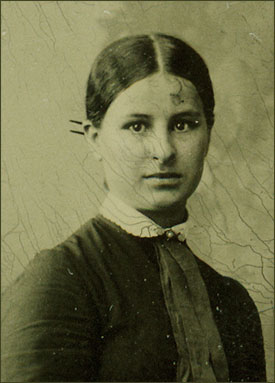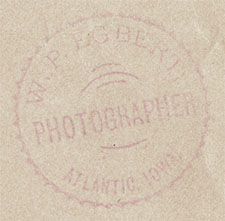|
- Sleeve Design
- Woman's Dress
- Background & Props
This well-preserved paper sleeve is typical of mid to late 1870s. Rich gold printing and the elliptical opening are hallmarks of the era.
Her dress with a simple collar and clean front brings the image closer to the 80s, possible in the early 1880s. Most of 1870s decade saw a very busy style of multiple scarves, necklaces, and lace on women. She does wear a single, simple scarf.
The layered skirt stresses the 1870s, yet they can still be found in the early 1880s before they gave way to clean lines.
Studio props began to get more sophisticated in the 1880s. Greater use of very attractive, soft backdrops was dominate. The vase on the table is in the 1880s style of props.
|
Estimated Date: 1880 +/- 2 Years
It is most useful to compare this image to styles of the 70s and 80s, regardless of type of photograph. Click Here for similar pictures.
Few tintypes were taken in this timeframe as formal portraits. Click here for tintypes in the gallery.
Tintype as a Formal Portrait
This tintype is from the transition period of tintype usage. After about 1880s tintypes were used less frequently as a serious, formal pro trait medium. Paper photographs, particularly the larger cabinet cards produced much nicer images.
This image was taken in Atlantic, Iowa, a rural town in western Iowa, about 7,500 residents today. The town photographer probably was still holding onto producing the older technology tintypes, and had not moved to the more popular cabinet cards of the larger cities or more progressive photographers.
|

This tintype exhibits cracking of the collodion base which the image was developed on. Collodion was poured over the tintype before a plate was sensitized with silver nitrate. The silver nitrate would attach to the collodion, not to the bare metal plate. Seen on many tintypes, cracking is the result of either too thick of collodion base or poor mixture quality.
|

This tintype has been handled very little and carefully. The sleeve still has intact the fragile overleaf. The overleaf, twice the width of the sleeve, was glued to the back of the tintype and sleeve. This kept the tintype placed correctly in the widow. With the extra paper extending to the right, this was now folded over the face, providing protection to the image.
 |
The photographer's stamp was placed on the back of the overleaf. Instead of buying pre-printed stock (which added to cost), many photographers used a stamp and ink pad to mark their work.
This faint stamp says "W.P. Egbert PHOTOGRAPHER Atlantic, Iowa. If this was an important photograph to family research, city directories and newspapers of Atlantic could be researched to determine when the photograph was in business. |
|